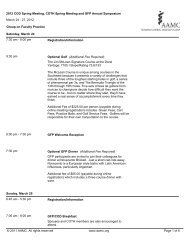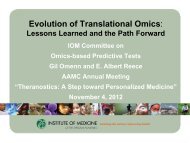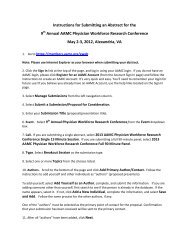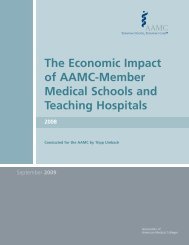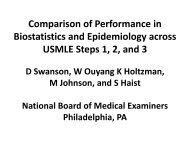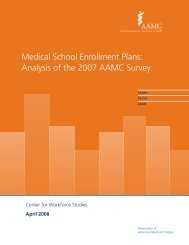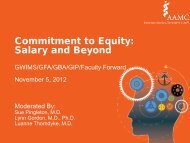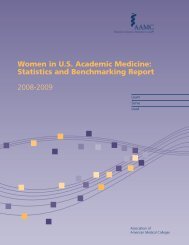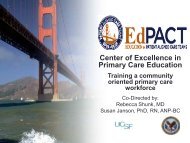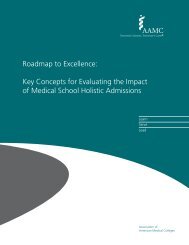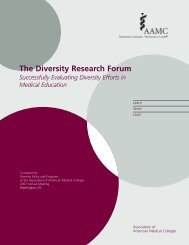Dashboard
Dashboard
Dashboard
You also want an ePaper? Increase the reach of your titles
YUMPU automatically turns print PDFs into web optimized ePapers that Google loves.
Institutional <strong>Dashboard</strong>s<br />
for Continuous Quality<br />
Improvement<br />
Deb Simpson, Medical College of Wisconsin (Moderator)<br />
Marc Triola, New York University<br />
Mary C. Hill, University of Michigan<br />
Henry Sondheimer, AAMC<br />
Robby Reynolds, AAMC<br />
1
Background:<br />
Why dashboards? Why now?<br />
Medical educators generate a LOT of data for<br />
different stakeholders<br />
New accreditation criteria for academic quality<br />
(LCME, ACGME, HLC)<br />
New expectations for data analysis and reporting<br />
• Link objectives to outcomes<br />
• Link individual, unit, and aggregate data<br />
• Cross-link data<br />
2<br />
2012 AAMC Annual Meeting
Background:<br />
Why dashboards? Why now?<br />
New approaches to evaluating and comparing<br />
outcomes require new tools<br />
Business has led the way in developing and using<br />
Business Intelligence (BI) technology<br />
<strong>Dashboard</strong>s are a navigational tool<br />
3<br />
2012 AAMC Annual Meeting
What is a <strong>Dashboard</strong>?<br />
Auto <strong>Dashboard</strong>?<br />
Or Cockpit<br />
Instrument Panel?<br />
4<br />
2012 AAMC Annual Meeting
Process & Objectives for Session<br />
Process<br />
WHAT: Intro & <strong>Dashboard</strong> Examples<br />
• NYU<br />
• Michigan<br />
• AAMC – MBM & ASSET<br />
NOW WHAT: Discussion Questions<br />
• What are key decisions/questions?<br />
• What data need/have/access?<br />
• Challenges in dashboarding data?<br />
• Benchmarking?<br />
SO WHAT: How do dashboards<br />
• Add value (to whom)<br />
• Support a CQI- edu.environment<br />
Goal & Objectives<br />
GOAL: Expand our awareness re:<br />
available data sets<br />
OBJECTIVE: Address the questions “you”<br />
want answered re:<br />
• Available data sets:<br />
• What you have<br />
• What others have (AAMC, USMLE)<br />
• What you don’t have<br />
• Benchmarks – Criterion<br />
5<br />
2012 AAMC Annual Meeting
Introduction: Decisions & ?’s<br />
Key Concepts & Terms<br />
Business Analytics<br />
Tell key stakeholders in multidimensional manner<br />
• Process: What’s happening now<br />
• Outcomes: What’s happening relative to “criterion”<br />
• Prediction: What MAY happen<br />
• Discovery: Something interesting<br />
Hammergren TC. Data Warehousing for Dummies. 2009<br />
Terkla DG. Institutional <strong>Dashboard</strong>s AIR 2012<br />
6<br />
2012 AAMC Annual Meeting
Business Analytics<br />
Key Indicators – THE critical information<br />
• Varies by institution/stakeholder/decision-maker<br />
• Indicators must be<br />
• Easy to understand<br />
• Relevant to user<br />
• Strategic<br />
• Not used in isolation<br />
• Quantitative; up-to-date with current info; reliable<br />
Hammergren TC. Data Warehousing for Dummies. 2009<br />
Terkla DG. Institutional <strong>Dashboard</strong>s AIR 2012<br />
7<br />
2012 AAMC Annual Meeting
Business Analytics – Tells key stakeholders by:<br />
Visualization of data<br />
• Multidimensional<br />
• Chronological (Past-Present & IF Predictive Future)<br />
Key Concept: Tell me a lot of things but don’t make me<br />
work too hard.<br />
• <strong>Dashboard</strong><br />
• Presents current information on your operational<br />
performance (car, airplane)<br />
• Purpose – manage/guide the organization<br />
• Scorecard<br />
• Shows performance against a plan, set of objectives,<br />
criterion/standards<br />
Hammergren TC. Data Warehousing for Dummies. 2009<br />
Terkla DG. Institutional <strong>Dashboard</strong>s AIR 2012<br />
8<br />
2012 AAMC Annual Meeting
<strong>Dashboard</strong> Examples<br />
9
The NYU Educational Data Warehouse<br />
Marc Triola, MD<br />
Associate Dean for Educational Informatics<br />
NYU School of Medicine Division of Educational Informatics
Overview<br />
• Background<br />
• Our Approach<br />
• Implementation<br />
• Lessons Learned and Next Steps
Background<br />
• Who we are<br />
• Our new curriculum: C21<br />
• With the rollout of C21, DEI had a goal<br />
to create a Framingham Heart Study<br />
style database of educational data
Needs<br />
• C21<br />
o<br />
o<br />
o<br />
Learning analytics at the individual level<br />
Curriculum mapping and management<br />
Regulatory reporting<br />
• Strategic operational dashboards<br />
o<br />
o<br />
o<br />
Admissions, Diversity Affairs, etc.<br />
UME, GME and Biomedical Sciences graduate program<br />
DEI
Benefits of an EduDW<br />
• Integrates metrics from numerous heterogeneous sources and enables<br />
analysis across multiple systems & processes<br />
• The EduDW architecture, based on dimensions and facts, promotes<br />
exploration:<br />
o<br />
o<br />
o<br />
o<br />
provides single analytic view that is easier for users<br />
insures high performance<br />
is supported by a variety of query & reporting tools<br />
facilitates creation of multidimensional cubes<br />
• Preserves historical data<br />
• Takes off the load of resource-intensive queries from operational<br />
systems
Education Data Warehouse<br />
Lecture<br />
Podcasting<br />
ePortfolio<br />
Evaluations<br />
Learning<br />
Modules<br />
Student<br />
Patient Log<br />
LMS<br />
SIS<br />
Exams<br />
Admission<br />
s<br />
Simulation<br />
ETL<br />
Data Marts<br />
EduDW<br />
BI<br />
Reporting and Analytics
Learning Analytics and Individual <strong>Dashboard</strong>s
Learning Analytics and Individual <strong>Dashboard</strong>s
Learning Analytics and Individual <strong>Dashboard</strong>s
Learning Analytics and Individual <strong>Dashboard</strong>s
Learning Analytics and Individual <strong>Dashboard</strong>s
Learning Analytics and Individual <strong>Dashboard</strong>s
Learning Analytics and Individual <strong>Dashboard</strong>s
Learning Analytics and Individual <strong>Dashboard</strong>s
Learning Analytics and Individual <strong>Dashboard</strong>s
Curriculum Mapping
Curriculum Mapping
Curriculum Management
Operational <strong>Dashboard</strong>s
Operational <strong>Dashboard</strong>s
Operational <strong>Dashboard</strong>s
Lessons Learned<br />
• Support within the organizational culture<br />
o<br />
Commitment from senior leadership<br />
• Ongoing partnerships between<br />
Informatics/IT, faculty and administration<br />
o<br />
An iterative process!
<strong>Dashboard</strong>s for Continuous Quality<br />
Improvement at the University of Michigan<br />
Mary Hill (maryhill@umich.edu)<br />
Director, Data Management Services<br />
University of Michigan Medical School<br />
November 6, 2012
Why? Manage Better and Smarter<br />
Being “successful” is a matter<br />
of survival<br />
We all are experiencing financial<br />
challenges…<br />
Doubling of the NIH budget is over<br />
Reductions in state support<br />
More restrictive funding in a world of higher<br />
compliance<br />
Mary Hill 11/6/2012
Looked at What’s Important<br />
• Determined relevant key performance<br />
indicators (KPIs) and benchmarks<br />
• Reviewed metrics currently in use<br />
• Ensured consistency with Leadership<br />
Vision and Strategy<br />
• Bring transparency and agreement<br />
• Don’t worry about getting goal “right”<br />
• Worry about being nimble<br />
Mary Hill 11/6/2012
University of Michigan<br />
First <strong>Dashboard</strong>:<br />
• Key constituents in one room<br />
• Pushed for set of KPIs in 3 months<br />
• Paper first – drew pictures<br />
• War room<br />
Mary Hill 11/6/2012
Current Status<br />
• Must be able to get to the data<br />
• Locally available<br />
• Peer – who are they?<br />
• Externally available<br />
• Numbers must tie back to something<br />
users trust<br />
• Allow drill down<br />
Mary Hill 11/6/2012
Process<br />
• Process of analysis brought<br />
changes to goals<br />
• Different departments different peers<br />
• Tied performance incentives to goals<br />
– brought engagement<br />
Mary Hill 11/6/2012
Learning Program Metrics<br />
Breakdown by area<br />
• Undergraduate<br />
• Graduate Basic Science<br />
• Graduate Medical Education<br />
• Continuing Professional Education<br />
Create metrics for:<br />
• Input<br />
• Throughput<br />
• Output<br />
Mary Hill 11/6/2012
Example Undergraduate<br />
Input<br />
• % admitted accepted to peer<br />
schools<br />
Throughput :<br />
• # Abstracts/Presentations<br />
Output :<br />
• Primary Care Focus %<br />
Mary Hill 11/6/2012
Example Graduate Basic Science<br />
Input<br />
• % Diversity<br />
Throughput :<br />
• #/$ students on Institutional<br />
Fellowships<br />
Output :<br />
• % in science related position five<br />
years post training<br />
Mary Hill 11/6/2012
Example Graduate Medical Education<br />
Input<br />
• #/% in-state resident<br />
Throughput :<br />
• #/% house officers engaged in<br />
Quality or Patient Safety Initiatives<br />
Output :<br />
• # publications with house officers<br />
as first author<br />
Mary Hill 11/6/2012
Example Professional Development<br />
Input<br />
• # Regularly Scheduled Series/# of<br />
attendees<br />
Throughput :<br />
• % CME participants providing post<br />
course evaluations<br />
Output :<br />
• # Papers published/#external<br />
presentations<br />
Mary Hill 11/6/2012
Snapshot<br />
Mary Hill 11/6/2012
Challenges<br />
• Keeping current – environment<br />
changes<br />
• Explosion of dashboards – everyone<br />
is doing –<br />
• Trying to keep a metric in one place<br />
• Have consistent user interface<br />
across the Health System<br />
Mary Hill 11/6/2012
AAMC Mission Management Tool<br />
• 2008 meeting of Group on Student Affairs<br />
• Challenge to give medical schools something<br />
better than USN&WR<br />
• Reviewed the MSAR for medical school<br />
missions<br />
• Six missions selected<br />
• First release March 2009<br />
2012 AAMC Annual Meeting
46<br />
2012 AAMC Annual Meeting
47<br />
2012 AAMC Annual Meeting
48<br />
2012 AAMC Annual Meeting
49<br />
2012 AAMC Annual Meeting
50<br />
2012 AAMC Annual Meeting
51<br />
2012 AAMC Annual Meeting
52<br />
2012 AAMC Annual Meeting
The Missions <strong>Dashboard</strong><br />
2012<br />
53<br />
2012 AAMC Annual Meeting
ASSET <strong>Dashboard</strong><br />
Monitor LCME Standards Performance Annually<br />
www.aamc.org/medaps<br />
www.aamc.org/medaps<br />
2012 AAMC Annual Meeting
MedAPS: Suite of Services<br />
Provide AAMC member medical schools with the<br />
tools necessary to assess, maintain and fulfill<br />
accreditation standards and promote continuous<br />
quality improvement.<br />
Curriculum Inventory<br />
& Reports<br />
(Replacing CurrMIT)<br />
ASSET<br />
(Accreditation Standards Self-<br />
Evaluation Tool)<br />
ASSET <strong>Dashboard</strong><br />
www.aamc.org/medaps<br />
2012 AAMC Annual Meeting
ASSET <strong>Dashboard</strong><br />
• Review performance on LCME standards<br />
annually<br />
• Compare performance<br />
and curricula with national<br />
data<br />
• Compare performance<br />
and curricula with peer<br />
institutions<br />
• Link to AAMC tools and solutions<br />
to help address deficiencies<br />
www.aamc.org/medaps<br />
2012 AAMC Annual Meeting
2012 AAMC Annual Meeting<br />
www.aamc.org/medaps
Populating MedAPS<br />
LCME AQ Part I-A<br />
Data Sources<br />
LCME AQ Part II<br />
ASSET<br />
(1/3 Pre-Populated)<br />
LCME AQ Part I-B<br />
Curriculum<br />
Inventory<br />
AAMC Data Warehouse<br />
Curriculum<br />
Inventory Reports<br />
Student Record System<br />
Graduation<br />
Questionnaire<br />
ASSET <strong>Dashboard</strong><br />
2012 AAMC Annual Meeting<br />
Faculty Database
MedAPS: Timeline<br />
Curriculum Inventory<br />
& Reports<br />
Phase 1: Upload School Data<br />
Launch<br />
ASSET<br />
Curriculum Inventory<br />
& Reports<br />
Phase 2: Launch Service<br />
2013 2014 2015<br />
Launch<br />
2012 AAMC Annual Meeting<br />
ASSET <strong>Dashboard</strong><br />
www.aamc.org/medaps
Discussion Questions<br />
•How can dashboards help schools monitor their individual<br />
missions? How are schools monitoring their missions<br />
without dashboards?<br />
•How can dashboards organize vast amounts of data to<br />
keep it from becoming overwhelming?<br />
•What data would be the most useful in a dashboard<br />
environment?<br />
•What are the data sources for dashboards? What are the<br />
challenges to collecting the data?<br />
•What are some questions you would like to be able to<br />
answer?<br />
61<br />
2012 AAMC Annual Meeting
Summary of Key Findings<br />
Next Steps<br />
So What ?<br />
Now What?<br />
62<br />
2012 AAMC Annual Meeting
References & Resources<br />
Alexander M. Excel 2007 <strong>Dashboard</strong>s & Reports for Dummies. Wiley Publishing. Hoboken, NJ<br />
2007.<br />
Arizona State University: http://www.asu.edu/dashboard/<br />
Arnold KE. Signals: Applying Academic Analytics EduCause Quarterly 2010<br />
Scheps S. Business Intelligence for Dummies. Wiley & Sons Hoboken NJ. 2008<br />
Eckerson WW Deploying <strong>Dashboard</strong>s & Scorecards TDWI Best Practices Report-July 2006<br />
Elias T. Learning Analytics: Definitions, Processes & Potential 2011<br />
LogiXML white paper: <strong>Dashboard</strong> Best Practices (2004). Fuchs, G.<br />
Hammergren TC & Simon AR. Data Warehousing for Dummies. Wiley Publishing. Hoboken, NJ.<br />
2009<br />
i<strong>Dashboard</strong>: www.idashboard.com<br />
Simpson D, Colbert J, Ferguson K, O’Sullivan P. BI & <strong>Dashboard</strong>s. Presented at SDRME Annual<br />
Mtg 2011. Madison WI.<br />
Terkla DG, Sharkness J, Cohen M, et al. Institutional <strong>Dashboard</strong>s: Navigational Tools for Colleges<br />
& Universities. Association for Institutional Research Professional Files Winter 2012 #123<br />
http://www.airweb.org/EducationAndEvents/Publications/Pages/ProfessionalFiles.aspx<br />
Baldrige Education Criteria for Performance Excellence. http://www.nist.gov/baldrige/<br />
63<br />
2012 AAMC Annual Meeting
Disclosure(s)<br />
I affirm that all persons involved in the planning/content development<br />
do not have relevant financial relationships with pharmaceutical<br />
companies, biomedical device manufacturers or distributors, or others<br />
whose products or services may be considered related to the subject<br />
matter of the educational activity.<br />
Partial funding for this MCW project was provided by:<br />
1. Educational Leadership for the Health of the Public Research and<br />
Education Initiative fund, a component of the Advancing a Healthier<br />
Wisconsin endowment at the Medical College of Wisconsin<br />
2. Drs. Elsa B. and Roger D. Cohen Children’s Hospital of<br />
Wisconsin/Medical College of Wisconsin Student Fellowship in Medical<br />
Education.<br />
64<br />
2012 AAMC Annual Meeting



